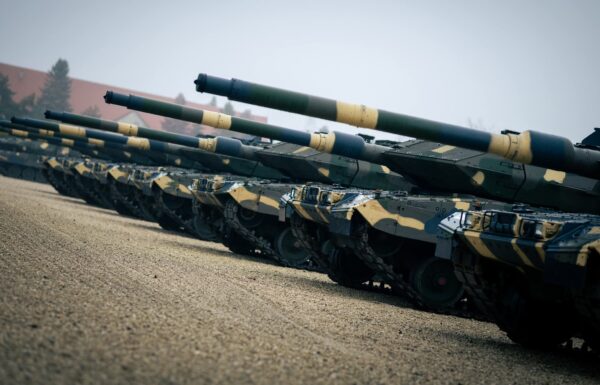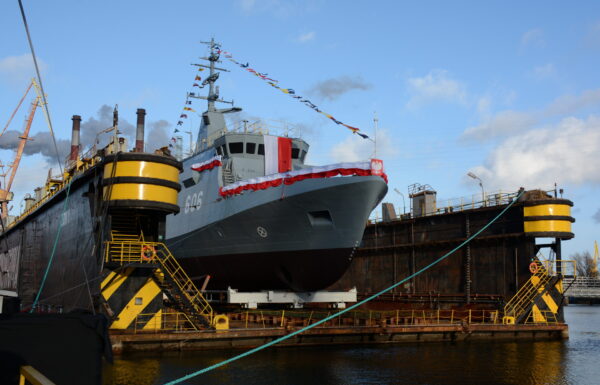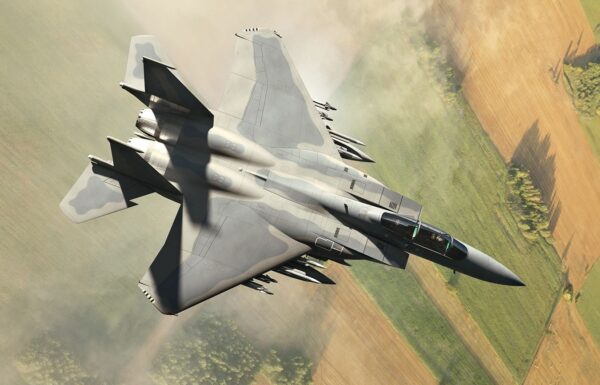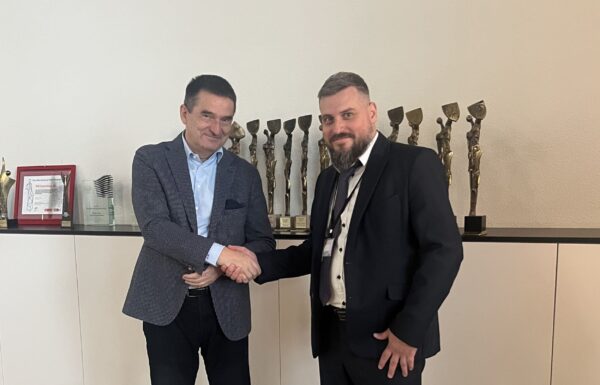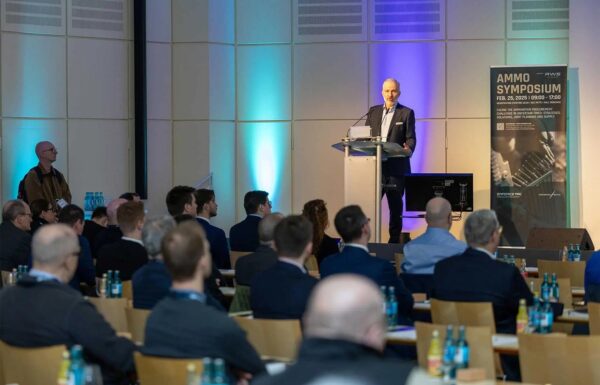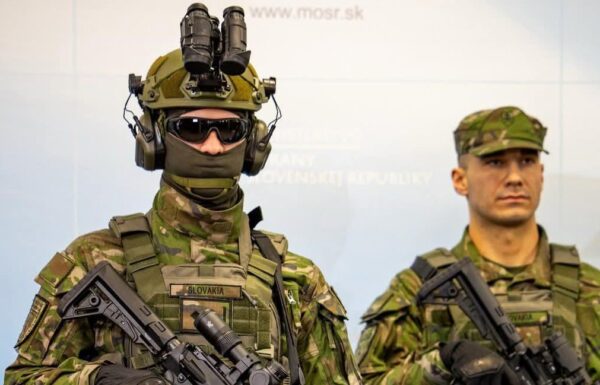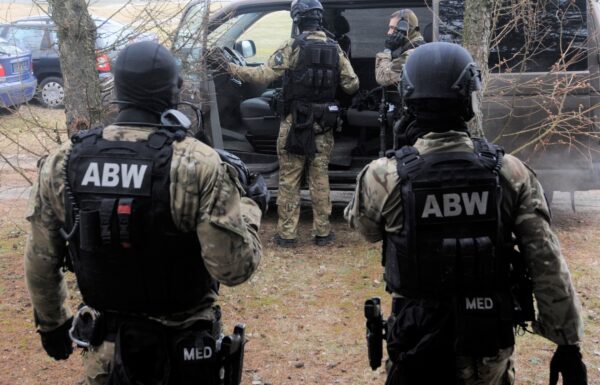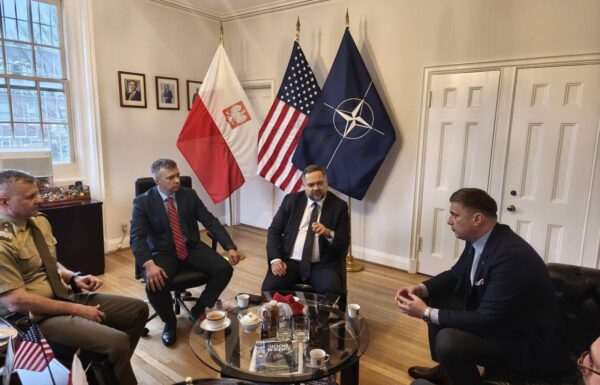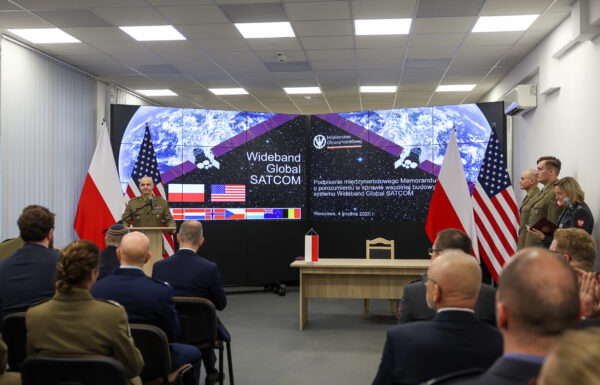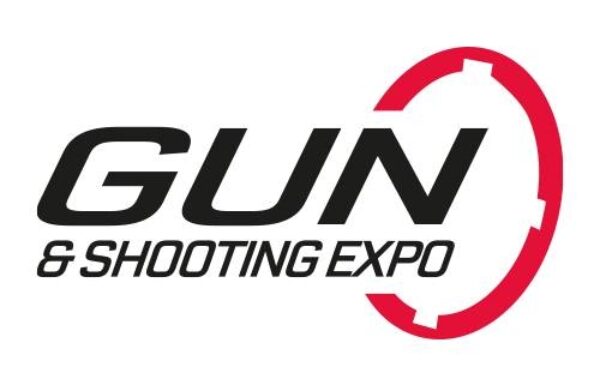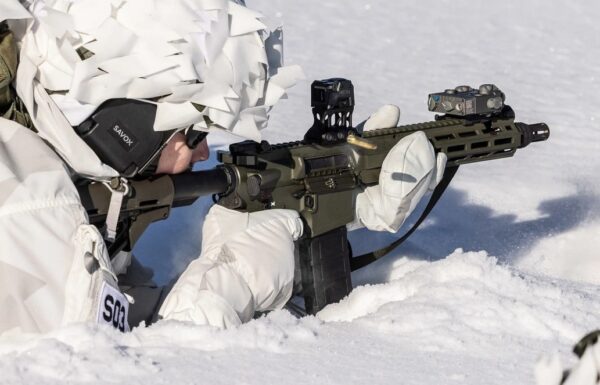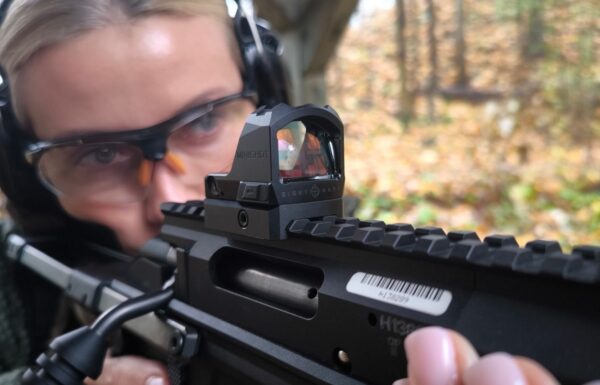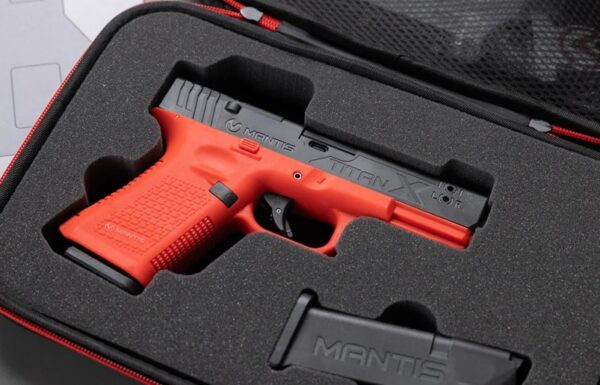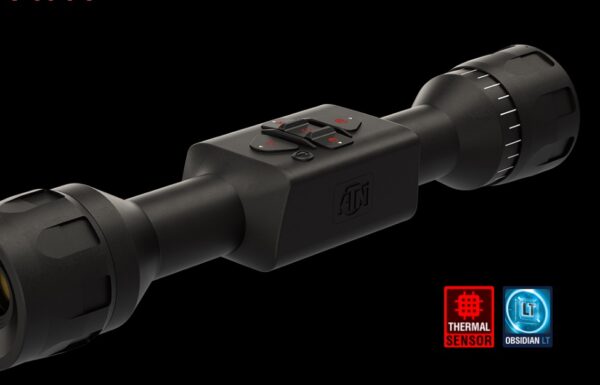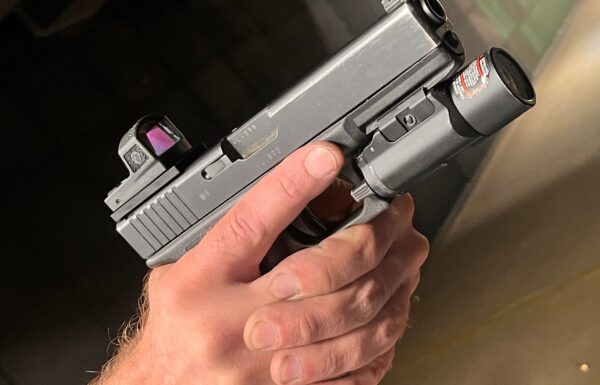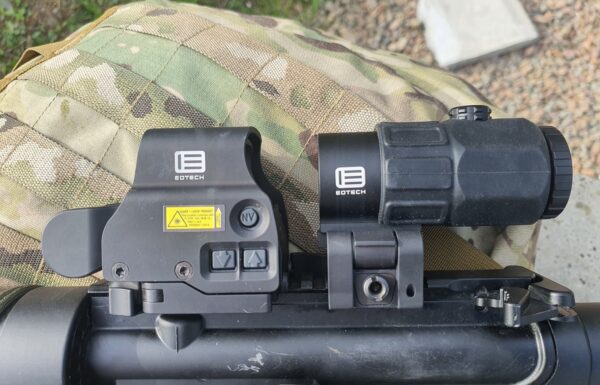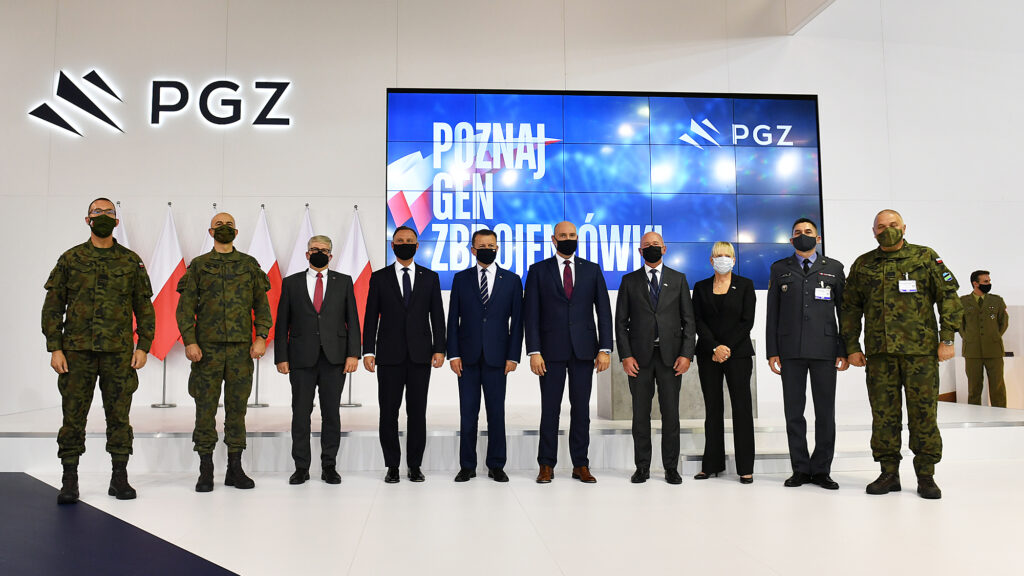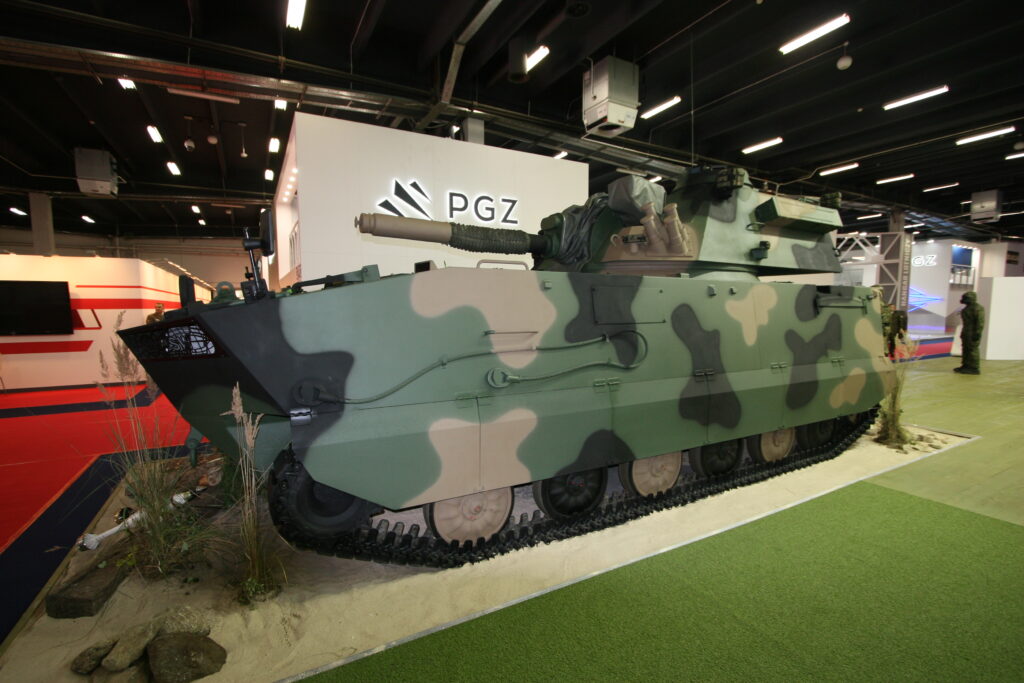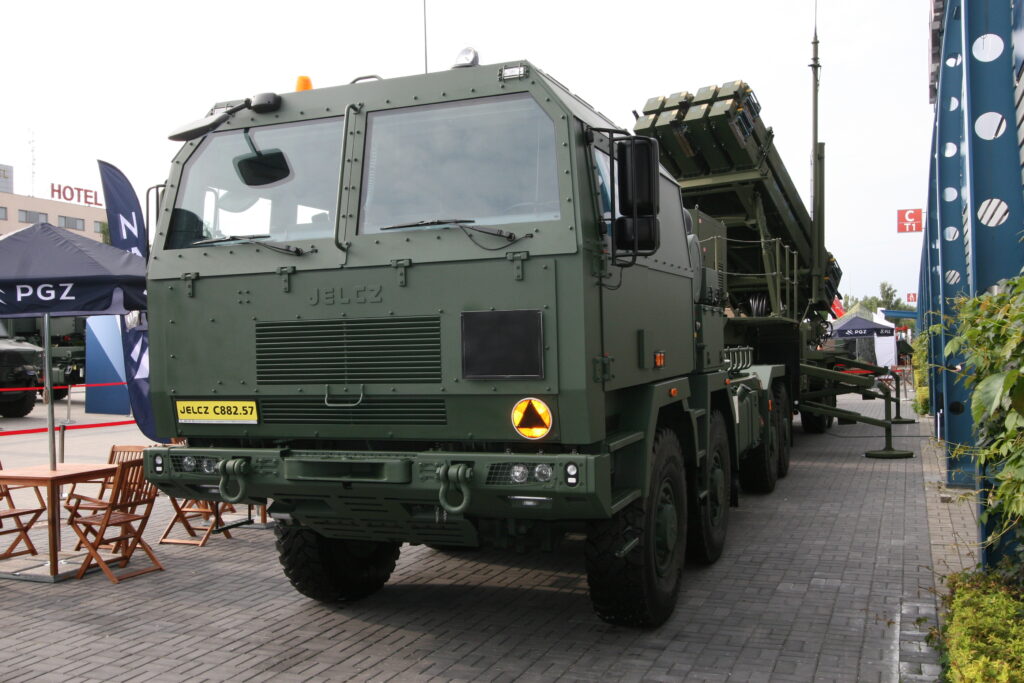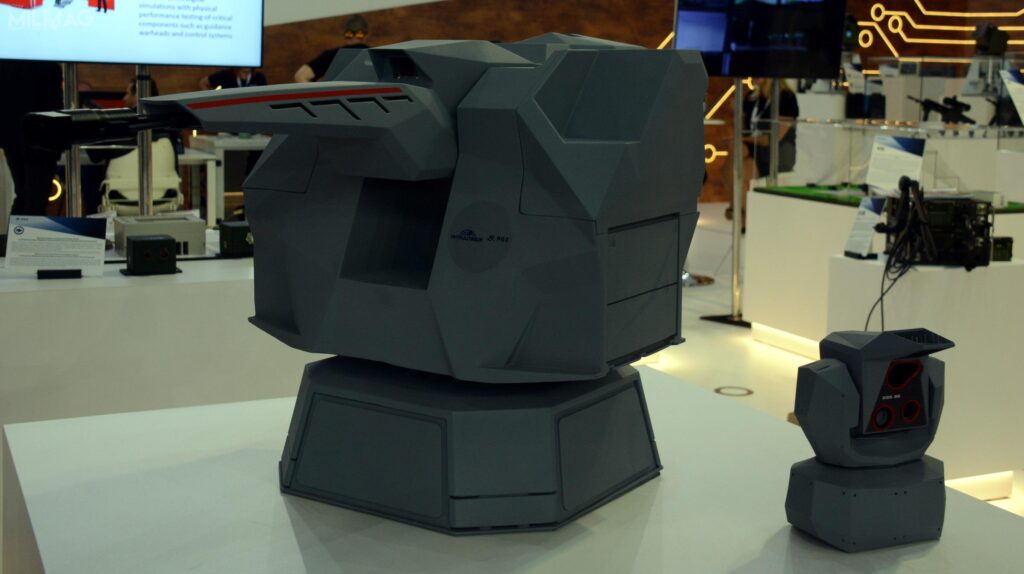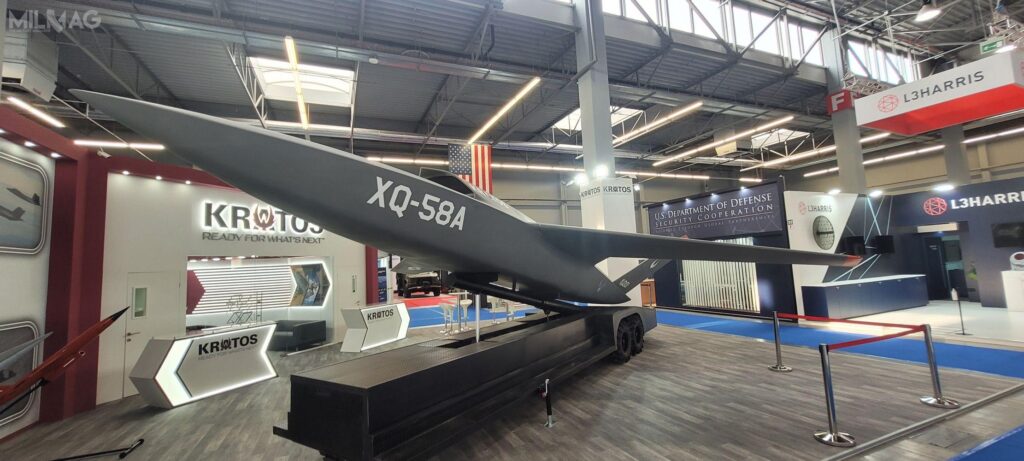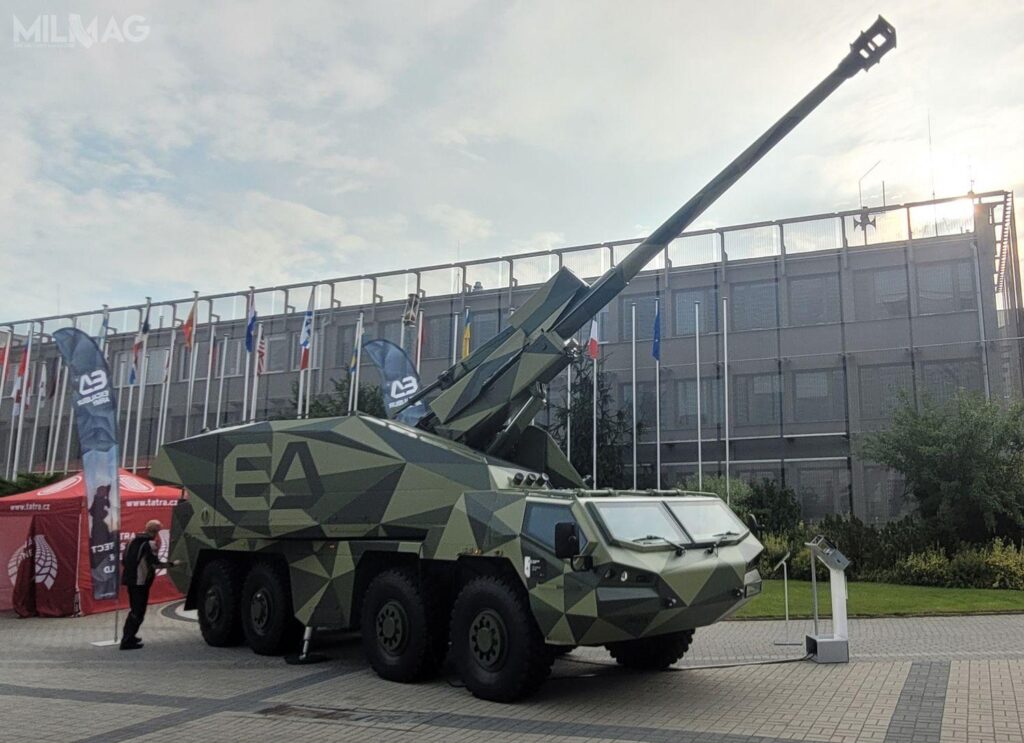On the first day of the exhibition, the Polish minister of national defense Mariusz Błaszczak signed a few contracts regarding modernization of the Polish Armed Forces. One of them was an arrangement with the PGZ-Narew Consortium (more about it later).
The chief of the Ministry Of National Defense also referred to a contract for deliveries of battlefield simulation systems for the Polish Armed Forces.
“I would like to stress the importance of the signed contract, which will allow creation of a complex battlefield simulation system on the existing Drawsko Pomorskie proving grounds, additional simulations will also be possible on the four other proving grounds, Orzysz, Nowa Dęba, Żagań, and Wędrzyn, forming a one larger system. That will help the Polish and allied soldiers improve their skills” noted minister Mariusz Błaszczak.
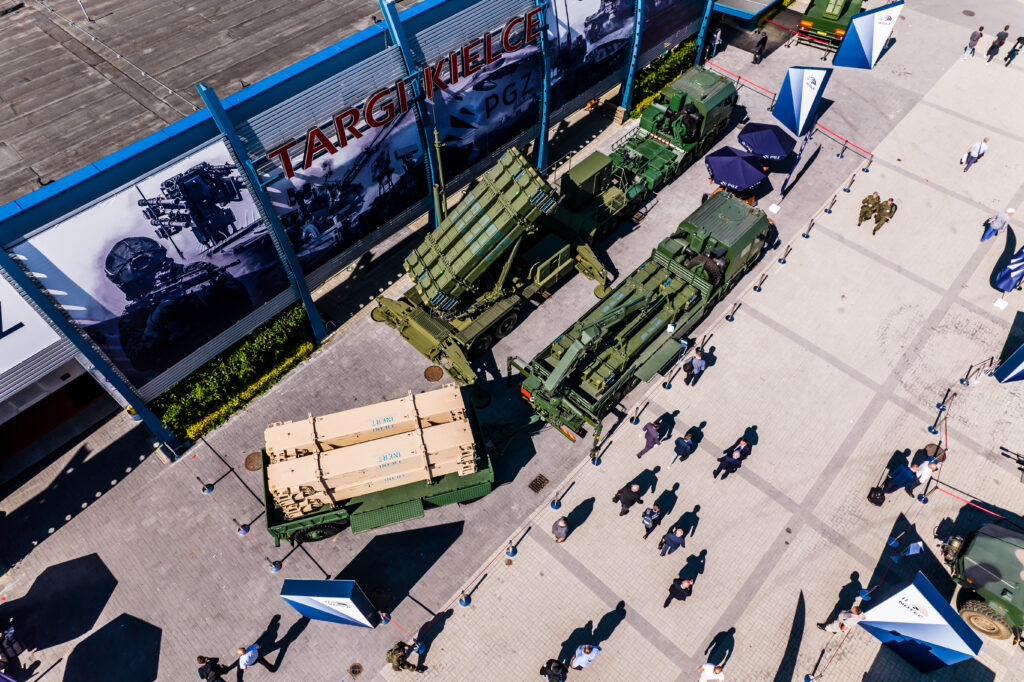
A set of vehicles of the Polish PATRIOT system configuration presented by Huta Stalowa Wola
Other contracts signed during the exhibition included delivery of 11 wheeled armored personnel carriers Rosomak RSK (Wolverine), an NBC reconnaissance variant, for 524.4 million PLN, 48 48 interrogators of medium (39 ISZ-50) and long (9 IDZ-50) range for IFF Mark XIIA/Mode 5 system for 162 million PLN, analytic laboratory for NUR-15M Odra radar, and the battlefield simulation systems for 570.3 million PLN (from Saab Defense And Security).
The minister also reminded of recent purchase contracts, including acquisition of Patriot systems, M142 HIMARS rocket launchers, multipurpose F-35A planes, Miecznik missile frigates for Polish Navy, and planned order for 250 M1A2SEPv3 Abrams main battle tanks. Other contracts signed within the last few years included supplying the Polish Armed Forces with M120K Rak self-propelled 120 mm mortar, and 155 mm AHS Krab self-propelled howitzer.
The primary attraction of the MSPO was the already mentioned M1A2SEPv2 Abrams tank. It served on battlefields of Middle East military conflicts (Iraq and Yemen). This tank is considered one of the best in the world.
“All of the contracts signed today are very important for the Polish Armed Forces. This is the realization of the modernization program set for years 2017-2026. Those processes are in effect, but we can be sure that gear will reach soldiers of the Polish Army. They will be able to fulfill their duties better and safer.” Noted the Polish president, Andrzej Duda, who was present when the contracts were signed.
M1A2SEPv2 Abrams tank being picked for the Polish Armed Forces was an attraction of the MSPO / Photo: Grzegorz Sobczak
Framework agreement regarding Narew
During the first day of MSPO 2021, PGZ-Narew consortium signed a framework agreement with Armament Inspectorate regarding short range anti-air missile launchers. It sets conditions for future contracts on delivery of components of the Narew system. Each of the individual contracts will cover development and delivery of elements for 23 sets of short range anti-air missile launchers. The framework agreement also covers acquisition of technological know-how, expansion of industrial potential, management of the project, and integration of the system.
As noted by the chief of The Ministry Of National Defense, the value of the signed contract is one of the highest in the history for the Polish Armament Group (PGZ), with a great importance not only for the Polish military but also for the Polish defense industry. The Narew program is the largest and the most complex modernization program in the history of the Polish Armed Forces. The chosen solution is aimed at the Polish defense industry, providing an opportunity for acquisition of new expertise and expansion of existing capacities regarding advanced armament systems.
Modernization of the Polish Armed Forces is closely tied to the local defense industry and represents a stimulus for development of innovation in that field.
According to PGZ CEO, Sebastian Chwałek, Narew program will be on scale vastly exceeding such projects as Regina or Miecznik.
The contract covers acquisition of missiles with suitable launchers, radiolocation devices including Multipurpose Fire Control Radar SAJNA, Early Detection Radar P-18PL, and Passive Location Radar PET/PCL, as well as mobile communication systems and training packages.
PGZ-Narew Consortium is composed of Polish Armament Group, which is also the leader of the consortium, Huta Stalowa Wola, Jelcz, Mesco, Ośrodek Badawczo Rozwojowy Centrum Techniki Morskiej, PCO, PIT-Radwar, Wojskowe Zakłady Łączności Nr 1, Wojskowe Zakłady Uzbrojenia, Wojskowe Zakłady Elektroniczne, and Zakłady Mechaniczne Tarnów. The project also provides opportunities for other entities, including those not belonging to the Polish Armament Group—private companies, research and development institutions, and academic centers.
The signed contract is the starting point for future agreements that will be negotiated in the near future. According to the adopted assumptions, the contracting of all elements should end in 2023, which should enable the first combat shooting from the integrated system in 2026.
The adopted formula in the form of a framework agreement and derivative executive agreements was chosen to minimize the risks of the timely implementation of air defense systems to the Polish Armed Forces and allows for the optimization of program management – both for the military and the industry.
The missile that is the key element of the system will be acquired as part of technology transfer from a foreign partner. Currently, the PGZ-Narew Consortium is conducting advanced talks with potential suppliers in order to obtain the broadest possible scope of competences and knowledge for the production and development of short-range anti-aircraft missiles within the consortium.
Three stages of Miecznik
Also on the first day of the Kielce exhibition, there was a presentation showing the current state of the Miecznik frigate construction program for the Navy. Program director Cezary Cierzan in his speech announced that he would regularly inform about the progress of work.
Currently, we are in the first stage, the industrial feasibility study. The PGZ-Miecznik consortium will develop three conceptual designs together with technical and economic analyzes, which should be completed in December this year.
The analyzes will be judging the proposals submitted as baseline projects by three foreign partners. These are the Arrowhead 140PL presented by the British company Babcock, the F-100PL from the Spanish Navantia and the MEKO A-300PL from the German TKMS. These companies have time until November 15th to submit their proposals.
A separate procedure is dedicated to development of integrated combat system (ZSW) configuration by PGZ-Miecznik consortium, It will be based on solutions already used in frigate constructions being used by other navies, adapted to needs of the Polish Navy. Design and conceptual work focusing on getting the manufacturing and servicing potential of PGZ Shipyards ready is taking place in parallel to preparation of technical proposals.
The Polish Armed Forces will be selecting one of the received proposals in February 2022. The industrial feasibility study will be finalized with approval of tactical and technical assumptions for Miecznik construction, which according to the timetable should happen in March 2022.
The second stage of the Miecznik program will be taking place from March 2022 to January 2023, when the initial project based on the selected design will be prepared and approved, together with technical and economic analysis. During that time, investments into development of PGZ Stocznia Wojenna (Military Shipyard) will be taking place, to ensure its production capacity will be adequate for demands of frigate construction.
The actual shipbuilding will be the final, third stage. According to the presented plan, the ready prototype will enter service by June 2028. This includes crew training, tests, and quality examinations.
After the prototype ship enters service, two more ships will be constructed, with planned dates of entering service being August 2033, and September 2034. By August 2034, all the logistic packages, and weapon systems for all three ships should be delivered as well.
Two premiers from Huta Stalowa Wola
Huta Stalowa Wola (HSW), which is part of PGZ, presented a new version of the M120G Rak self-propelled 120 mm tracked mortar on a new Light Tracked Chassis (LPG) during the 29th International Defense Industry Exhibition. HSW abandoned the use of the lower body of the 122-mm 2S1 Goździk self-propelled howitzer. LPG is a chassis made from scratch by HSW.
Huta Stalowa Wola presented a new variant of 120 mm M120G Rak self-propelled mortar with a new light tracked chassis / Photo: Grzegorz Sobczak
Compared to the previous version of M120 Rak self-propelled tracked mortar, the new chassis received a hydropneumatic suspension with 12 wheels (the previous undercarriage had 14 wheels) and supporting rollers. A new floor structure was also used with a new structure made from scratch, which increases the level of mine protection.
The most visible change is the reference of the appearance of the mortar hull to the design of the prototype of the new Borsuk amphibious infantry fighting vehicle (NBPWP).
The applied solutions will provide greater comfort to the crew of the vehicle during movement and firing (including reduction of vibrations and shocks). The presented mortar is the result of HSW’s work, which continues the development program of the company-level asset of the 120 mm Rak self-propelled mortars on a tracked chassis.
The new vehicle fits into the concept of modular construction of artillery systems, which assumes the greatest possible unification of equipment with the most optimal level of use of existing technical solutions – a new lightweight tracked chassis is used in the Regina program for command vehicles and command and staff cars, and in the Rak program as an artillery command vehicle and artillery reconnaissance vehicle.
A new armored 4×4 vehicle also appeared at the HSW stand. It is a basic chassis that was developed for the needs of the Missile Forces and Artillery, including their command and reconnaissance vehicles for the future division-level asset 155-mm Kryl wheeled gun-howitzer and 122-mm Langusta rocket artillery.
The vehicle was designed in cooperation with Czech company Tatra Export, with the HSW being responsible for the bodywork. It is intended as an universal platform for development of specialized vehicles for different kinds of units, including being proposed for the Pegaz project for Special Forces.
The tactical multipurpose vehicle can be configured, among the other options, as a command vehicle, multipurpose special forces vehicle, artillery reconnaissance vehicle, firing points reconnaissance vehicle, liaison officer vehicle, light tank destroyer, NBC reconnaissance vehicle, carrier of light weapons systems, radar platoon commander’s car, platform for demining patrols carrying out neutralization of Improvised Explosive Devices (IEDs) or a vehicle for transporting personnel and equipment of tactical airspace control teams.
The basic variant will have personnel of two, and will carry six armed and fully equipped soldiers. The armored plating will protect the crew from projectiles and shrapnels. The vehicle provides level 2–4 of ballistic protection and 2a/2b–3a/3b mine protection according to STANAG 4569 norms.
The presented variant of the 4 × 4 vehicle (unladen weight of 13 tons, with the maximum weight going as far as 18 tons) uses the Tatra 815-7 chassis and an automatic six-speed gearbox ALLISON 4500SP, which can be coupled with a Tatra (300 kW) or Cummins (270 kW) engine.
Design of the cabin allows introduction of changes, including adaptation to future specialized applications in the armed forces. The modular design will enable future expansion to a 6 × 6 or 8 × 8 configuration.
The tactical multipurpose vehicle can travel at speeds of up to 110 kph and has a range of up to 700 km. Without preparation, it can cross fords up to 1.2 m, it can also cross walls up to 0.5 m in height and ditches up to 0.9 m deep. The height of adjustable suspension is from 260 to 430 mm.
Ultimately, the vehicle will be manufactured by HSW in Poland, with the possibility of locating a part of the production at the Autosan factory in Sanok, which HSW co-owns with PIT-Radwar.
Taktyczny pojazd wielozadaniowy może poruszać się z prędkością do 110 km/h i ma zasięg do 700 km. Bez przygotowania może pokonywać brody do 1,2 m, może także przekraczać mury do wysokości 0,5 m oraz rowy o głębokości do 0,9 m. Prześwit regulowany wynosi od 260 do 430 mm.
Docelowo pojazd będzie produkowany przez HSW w Polsce, z możliwością ulokowania części produkcji w sanockiej fabryce Autosan, której HSW jest współwłaścicielem wspólnie z PIT-Radwar.
The timetable of F-35 deliveries
During MSPO 2021, Lockheed Martin revealed the details of the F-35 delivery schedule for Poland. Until recently, we only knew general information about the purchase of F-35 aircraft by Poland. During the second day of the MSPO 2021 exhibition, JR McDonald, Lockheed Martin’s Vice President of Aviation Program Development, revealed some details about the delivery schedule.
Production of the first F-35s for Poland is scheduled to begin in 2022. Delivery of the first aircraft is scheduled for 2024. The first eight units, scheduled for delivery in 2024/25, however, will not be delivered to Poland immediately. They will remain in the US and will be used to train our first group of pilots, as is the case with many other F-35 users. The first plane should reach Poland in 2026. According to the information provided by JR McDonald, the full operational capacity of the Polish F-35s is planned for 2030.
Lockheed Martin representatives also announced the planned Block 4 modernization, increasing some of the F-35’s combat capabilities. Its introduction is scheduled after the date of Polish planes leaving the Lockheed Martin factory. However, they will be covered by the TR-3 (Technology Refresh) program, which will prepare our F-35 for later modernization. As a result, all design changes will be introduced at the production stage, and the modernization will be limited only to the introduction of the latest software version.
According to the presentation shown during MSPO 2021, Polish F-35s will be stationed in Łask and Świdwin. JR McDonald also drew attention to the fact that Polish aviation plants are already part of Lockheed Martin’s global supply chain in the F-35 production process. As he emphasized, chassis components as well as engine and ammunition components are manufactured in Poland.
Combatmate
During this year’s MSPO, the Combatmate multi-purpose combat vehicle, developed by the Polish WB Group in cooperation with the South African company Bruisertech, had its premiere.
The vehicle is based on the Bruiser 212 armored, mine-resistant car and will be offered in a reconnaissance version for uniformed services and as a carrier for unmanned systems. WB Group informs that Combatmate is a modular platform, cost-effective, easily adaptable to the user’s needs, and equipped with solutions offered by the Polish concern. The presented vehicle has been integrated with the FONET vehicle communication system, TOPAZ battlefield management system and COMP @ N and PERAD radio communication systems. The vehicle presented in Kielce was also equipped with a stabilized, remotely controlled Arex ZSU-03 weapon station, equipped with a 12.7 mm large-caliber M2HB machine gun, four smoke grenade launchers and reusable Warmate-TL (Tube Launch) loitering munition launchers.
The ZSU-03 measures 1.64 x 0.92 x 0.63 m and weighs 203 kg (243 kg with M2HB). It is equipped with a color day camera with a resolution of 1920 × 1080 pix with a CMOS 1/3 “sensor and a thermal camera with a resolution of 640 × 480 pix with an uncooled FPA bolometer sensor, as well as a laser rangefinder with a beam length of 1.54 μm and a range of 50-4000 m The station can use the main armament in elevation from -10º to + 50º and azimuth up to 360º.
As for the Combatmate platform itself, the vehicle is 5,939 mm long, 2,488 mm wide, 2,660 mm high (3,098 mm with weapon station), 3,500 mm wheelbase and 420 mm ground clearance. The maximum angle of ascent to a terrain obstacle is 37 degrees, and of descent – 38 degrees. The operational range of the vehicle is 2,000 km.
In the basic version, the Bruiser 212 has a two-person crew and can transport up to 10 soldiers, and weighs 10 tons (of which 3 are payload). The vehicle reaches up to 140 kph on paved roads thanks to the Cummins 6-cylinder diesel engine with 268 kW and 1100 Nm torque. The vehicle is equipped with 14: 00x20R tires, and the turning radius is 14 m.
Airbus offers space cooperation
During the MSPO in Kielce, Airbus Defense and Space presented its products and services related to defense, space and security.
As Sebastian Magadzio, representative of Airbus in Poland, said: “Airbus has been offering its solutions to the Polish aviation industry for 20 years. Today we focus on developing and adjusting our competences in the field of defense, space technologies, and internal security, and responding to the needs of our client, the Polish Armed Forces, as they undergo intensive technical modernization. “
The presented key products include the C295 medium transport plane, used for various tasks: tactical and logistic transport, cargo discharge, medical evacuation (MEDEVAC) or maritime patrolling and electronic reconnaissance (SIGINT).
In the aviation area, the A330-200 MRTT (Multi Role Tanker Transport) transport and refueling aircraft, based on the civil Airbus A330, was presented, which can complement the current composition of the Air Forces.
Airbus also offers access to the constellation Pléiades Neo, which obtains 30 cm native resolution satellite images every day from anywhere in the world. Thanks to the high mobility and quick task planning and the use of Airbus geostationary satellites of the SpaceDataHighway system (the so-called space infostair, developed under the European Data Relay System, EDRS program), the constellation Pléiades Neo can provide images in less than 40 minutes since their taking, which allows quick reaction in critical situations.
In addition, in the area of commercially available imaging, Airbus can effectively support the Polish Armed Forces in the development of competences related to image analysis and processing and Coalition Shared Data (CSD) software, enabling them to gain operational advantage.
Airbus employs approximately 800 people in Poland in Warsaw, Łódź and Mielec. The company supports the efforts of the Polish aviation industry to restore engineering and production capabilities.
At the same time, Airbus meets the government’s ambitions in the development of the space sector and is ready to meet the requirements of the technical modernization of the Polish Armed Forces, taking into account the transfer of technology and know-how.
Łukasiewicz And PGZ join forces
During this year’s MSPO, the Łukasiewicz Research Network signed a cooperation agreement with the Polish Armaments Group in the area of research and development. The document was signed by the vice president of the Łukasiewicz Research Network, Michał Janasik, and the chairman of the board of Polska Grupa Zbrojeniowa, Sebastian Chwałek.
The cooperation will consist mainly in the joint implementation of undertakings, projects or programs related to the initiation and application of newly developed technologies. The plans of the Łukasiewicz Research Network and PGZ provide for close cooperation in missile, ammunition, armored, air defense and C4 programs (Command, Control, Communication And Computer), solutions for cybersecurity, aviation platforms and specialized unmanned platforms.
“Łukasiewicz has been working on solutions for Polish defense and security for two and a half years now, and its composite institutes have done it for many years,” said Michał Janasik, vice president of the Łukasiewicz Research Network. “As a network of 32 institutes, Łukasiewicz is an excellent partner for the implementation of research and development works for defense purposes. We have exceptional competences and expertise for the development of defense and national security in all our 4 lines of activity: smart and clean mobility, digital transformation, sustainable economy and energy and health. “
“The partnership with the Łukasiewicz Research Network is another step that will allow us to increase the pace of research, development and implementation in key areas for us – missile technology, communication and command support systems as well as autonomous platforms, both land, surface, and air” Sebastian Chwałek, president of the management board of PGZ, emphasized. “The experience and potential of the specialists from Łukasiewicz is a significant injection of fresh blood to our development area, the effects of which we will be able to present to you soon.”
The Łukasiewicz Research Network and PGZ have agreed that, based on their competences and experience, they will strive for mutual support in research and development activities as well as those related to the sale of the final product. For this purpose, they plan to establish a steering committee and working groups dedicated to specific activities, which will identify possible areas of cooperation and will be a place for exchanging experiences.
It is worth recalling that on July 31, 2020, the Łukasiewicz Research Network signed a letter of intent on cooperation with the Ministry of National Defense for the modernization of the Polish Army, whose main partner in this regard is the Polish Armaments Group. The agreement will harmonize the planning of scientific research and development works with the process of programming the development of the Polish Armed Forces and activities within the framework of cooperation between the Ministry and science and industry will allow direct work on technologies necessary to achieve specific operational capabilities of the Polish Army.
Patriot kit with launcher from HSW
During MSPO 2021, HSW and its subsidiary Jelcz, presented elements of the anti-aircraft and anti-missile defense system acquired by the Ministry of National Defense as part of the first stage of the Wisła program. HSW has presented the M903 launcher of the MIM-104F Patriot PAC-3 + (Post-Deployment Build 8) anti-aircraft and anti-missile defense system, built in Poland as part of an offset in the first phase of the Wisła program. HSW is to deliver 16 + 1 of them under the agreement made on March 14, 2019 with Raytheon Integrated Defense Systems, to equip two missile batteries.
The M903 launcher was presented together with the Jelcz C882.57 (CSS 8 × 8) tractor unit with a 6-seater armored cab, 625 HP MTU 6R1500 diesel engine with ZF automatic transmission and improved Hendrixen suspension. The launcher is integrated with the M860 semi-trailer, which is powered by a 15 kW generator with a frequency of 400 Hz. The M903 consists of sixteen launch containers for the Patriot Advanced Capability-3 (PAC-3) Missile Segment Enhancement (MSE), launcher mechanical assembly (LMA), launcher electronic module (LEM) and launcher interconnection group (LIG) along with LMRD control modules (Launcher Missile Round Distributor).
The launcher is 5.2 m long, 2.78 m wide and 1.57 m high (in the travel configuration).
A remote-controlled launcher can be deployed up to 1000 m from the AN / MSQ-104 command post. Communication with the command post takes place via a fiber-optic link or a single-channel SINCGARS radio operating in the VHF range.
One of the eight Jelcz P882.57 type transport and loading vehicles (STZ) ordered by the Ministry of National Defense (STZ) with a semi-trailer from Autosan, which was developed in cooperation with the Military Armament Works (WZU), was presented. The car and the trailer are capable of transporting sixteen launch containers with the PAC-3 MSE interceptor missiles.
During the MSPO, Huta Stalowa Wola presented the first M903 launcher for MIM-104 Patriot anti-air defense system built in Poland / Photo: Grzegorz Sobczak
OSU-35K for Kormoran II
At MSPO 2021, PIT-Radwar presented the latest version of the OSU-35K ship weapon system with a 35mm automatic cannon. The stand shows a completed integrated tracking head ZGS-35 and a model of the planned AM-35 artillery mount.
The system is being developed for the 258 Kormoran II mine countermeasure vessel project—the future ORP Albatros and Mewa. According to the information obtained by the editorial office of MILMAG, according to the current schedule, the complete OSU-35K should be ready to be installed on the minehunter by the end of the year, and the assembly could take place at the turn of or at the beginning of the next year.
The OSU-35K includes the following main components: the AM-35 35mm automatic naval gun; integrated observation and tracking head ZGS-35; block of the BSKO fire control system; reserve fire control position of the RSKO.
The presented AM-35 naval gun is its latest version, in which carbon fiber composites were used reducing the weight of the entire station. According to the current assumptions, it will weigh 3300 kg without ammunition. The KDA licensed automatic cannon has a rate of fire of 550 rounds / min and is powered by two magazines with a capacity of 100 rounds each. Thanks to the dual-sided ammunition feeding, two types of ammunition can be used interchangeably, such as sub-caliber (FAPDS-T) and programmable (ABM), which allows for more effective fight against various types of threats. The AM-35 has an elevation angle in the range from -10º to + 85º, allowing it to fight both surface and air targets. The station also has its own targeting camera with a resolution of 1920 × 1080 (3.2 Mpix), which enables firing even in the case of a failure of the main control system using the RSKO fire control station.
The main aiming device of the system is the integrated ZGS-35 tracking head with a thermal imaging camera, daylight camera, laser rangefinder, video tracker and the IKZ-50P short-range interrogator of the IFF identification system. The thermal imaging camera operating in the 3-5 µm band enables the detection of a target measuring 0.8 x 1.7 m from a distance of up to 11,800 m, recognition at a distance of 4330 m, and identification at 2,250 m.
These distances increase to 15,000, 7660 and 4060 m, respectively, in the case of a larger target with dimensions of 2.3 x 2.3 m. A TV camera operating in the visible light band of 350-700 nm allows to detect an object with dimensions of 0.75 × 1.5 m at a distance of 8000 m, recognition at a distance of 2000 m and identification at 1000 m. The laser rangefinder has an apparatus range in the range of 200-30,000 m.
The BSKO fire control system block enables automatic, semi-automatic, and manual operation. It also ensures the integration of data exchange within the OSU-35K, as well as its cooperation with the ship’s combat management system.
Dummies of the current variant of the AM-35 naval gun with an integrated ZGS-35 tracking head/ Photo: Przemysław Gurgurewicz
Valkyrie for the Air Force
The Kratos Defense & Security Solutions company from the USA presented in Kielce the XQ-58A Valkyrie unmanned combat aircraft as an offer for the Polish Air Force. At the fair, a full-size model of the aircraft was presented, as well as reduced models of the UTAP-22 Mako and BQM-167 Skeeter drones.
As the MILMAG editors learned, the XQ-58A Valkyrie, which is still basically a technology demonstrator, is offered in the program under the code name Harpii Szpon (Harpy’s Talon), which assumes the acquisition by the Polish Army of the so-called loyal wingman, i.e. combat drones equipped with artificial intelligence and providing support for manned aircraft.
Interestingly, according to the assurances of the representatives present at the Kielce MSPO, the Valkyrie could work with both the multi-role F-35A Lightning II and the older F-16C / D Block 52+ Advanced aircraft. Most importantly, Kratos Defense & Security Solutions has started talks with an undisclosed Polish company regarding this matter.
The XQ-58A Valkyrie, originally designated as XQ-222, is being developed since 2016 as a expansion of the aforementioned UTAP-22 Mako for the American Low Cost Attritable Strike (LCAS) program as a support primarily for the F-35A Lightning II and F-22A Raptor aircraft, but also the older 4th generation fighters, and bomber planes. Later it was included in the Skyborg Vanguard autonomous reconnaissance unmanned aerial vehicle program as a technology demonstrator.
In December 2020, the XQ-58A was used as a platform to carry the gatewayONE data relay for secure communication between the F-22A and F-35 aircraft, and in April 2021 participated in test release of cargo from the internal weapons compartment – a small ALTIUS-600 reconnaissance unmanned aerial vehicle.
On July 28, 2021, information was published that the XQ-58A technology demonstrator, serial number 15-8001, will be withdrawn from tests and will be transferred to the National Museum of the American Air Force (US Air Force, USAF) at the Wright-Patterson air base in Ohio (on October 9, 2019, it had an accident on landing during the third test flight; a second copy, No. 15-8002 was built). So far, both copies have made eight disclosed flights.
XQ-58 Valkyrie unmanned aerial vehicle dummy / Photo: Jakub Link-Lenczowski
DITA as a successor to DANA
The new 155 mm wheeled DITA cannon howitzer was presented at this year’s MSPO at the joint stand of the Czech companies Excalibur Army (part of the Czechoslovak Group) and Tatra Trucks. The first visualization of the vehicle was unveiled on January 18 this year.
Works on the DITA gun started in 2019 as a successor to wz. 77 DANA gun-howitzer, and its modernized variants M1, and M2.
DITA uses the Tatra 815 VP31M chassis in an 8 × 8 drivetrain with a cabin previously used in the upgraded DANA M1 and M2. The new gun is equipped with a new, unmanned turret, and the crew of the vehicle consists of two soldiers (the position on the left side of the turret is only used in an emergency).
The crew cabin has ballistic protection level 1 according to STANAG 4569 A. The vehicles were equipped with a digital fire control system with an automated targeting system ASAP (Automatic Setting of Action Position) and a system for selecting ammunition and controlling its loading. Additional equipment includes the Battle Management System (BMS), a self-diagnostic system, a navigation system, a tire pressure regulation system, an air-conditioning system with a built-in NBC protection system against the effects of the use of weapons of mass destruction, and an auxiliary power generator. Thanks to the latter, it is possible to fire with the engine off.
The vehicle has a total length of 13.02 m (with the barrel pointing forward), 3.085 m width, 3.122 m height, and the combat weight is 29 tons. The vehicle is powered by the Tatra T3-928-90 V8 diesel engine with a power of 408 HP (300 kW). ), which allows reaching speeds of up to 90 kph on a paved road and 25 kph in the field, and a range of 300 to 600 km (off-road or on the road, respectively). The vehicle can overcome water obstacles up to 1.2 m deep, elevations up to 30º degrees and slopes up to 15º, terrain obstacles up to 0.47 m high and ditches up to 2 m wide.
The main armament is a 47-caliber long 155 mm cannon howitzer, with a 12.7 mm NSVT machine gun acting as a secondary armament. When using DN1CZ ammunition with a gas generator, the effective firing range is 39 km, the rate of fire is 5-6 rds / min. The barrel elevation angle is from – 3º to + 70º. The vehicle carries a reserve of 40 units of ammunition.
Joint stand of Czech companies Excalibur Army and Tatra Trucks presenting new 155-mm DITA wheeled gun-howitzer during MSPO 2021
Technical assistance Rosomak
The prototype of the Rosomak-WPT technical assistance vehicle made its public debut at the stand of the Rosomak company from Siemianowice Śląskie. This vehicle is intended to provide the technical support for the operations of combat units equipped with Rosomak (Wolverine) wheeled infantry fighting vehicles. Taking into account the nature of the activities and the system configuration of the vehicle, the base platform has been equipped with a new suspension system bracket, increasing the gross vehicle weight from 26 to 28 t, and a new powertrain that ensures an appropriate power-to-weight ratio.
The Rosomak-WPT with on-board and off-road equipment will perform tasks including removing trapped and bogged down vehicles, removing terrain obstacles, pushing other vehicles and paving the way, removing the power pack with the engine and the Hitfist 30P manned turret from Rosomak IFV, providing basic technical aid, evacuating damaged vehicles, carrying out ad hoc repairs of damaged vehicles in order to restore their ability to continue operating or move independently, perform diagnostics, and service teams and systems of the IFVs in the field.
The design of the armor systems of the German company Rheinmetall used in the vehicle provides the crew’s ballistic protection against projectiles at level 4 according to the STANAG 4569 A standard and anti-mine protection at level 2 according to STANAG 4569 B. The vehicle is 8,960 mm long, 3,220 mm wide and 3,070 mm high. The maximum speed on the road is over 100 kph, and the operating range is 500-600 km.
The Rosomak-WPT is also equipped with a HIAB S-HiPro 130 hydraulic crane with a lifting capacity of 12.5 kNm, which is used to lift and move loads in the permitted working area, and a Pearson Engineering blade that serves as an anchor for the side winch assembly, supports for the crane operation and for pushing other vehicles and paving the way.
In order to ensure the protection of the vehicle and maintain the ability to conduct combat operations by the crew, the vehicle was equipped with a remotely controlled weapon module from the ZSMU family made by Zakłady Mechaniczne Tarnów (ZMT) fitted with a 7.62 mm UKM-2000C machine gun. The cameras used for daytime observation and thermal imaging allow the crew to conduct effective fire during the day and at night. The equipment is identical with the Rosomak-WRT technical reconnaissance vehicle.
Dawid Piecuch, an independent specialist for design analyzes from Rosomak company, said in an interview with the MILMAG editorial office that the prototype of the Rosomak-WPT technical assistance vehicle received a new drive unit: a four-stroke, 6-cylinder in-line turbocharged diesel engine with a Scania DC 13 079A intercooler. 550 hp (405 KW) with the ZF Ecomat gearbox.
As the representative of the Rosomak company added, the hydraulic crane in the technical assistance vehicle will also be able to dismantle the new ZSSW-30 towers, which are planned to be ordered by The Ministry of National Defense for Rosomak, which will be a simpler task, because as an unmanned turret it does not have a basket, unlike the Hitfist 30P.
The crew of the Rosomak-WPT consists of four soldiers (commander-gunner, driver and two mechanics), the vehicle is equipped with smoke grenade launchers and the SSP-1 Obra-3 laser warning system. It also has two winches. Interestingly, unlike the Rosomak, the technical assistance vehicle uses an electric pump to open the engine hatch.
The driver’s compartment uses a new multi-function display from Patria with locally written software to monitor the critical condition of the powertrain, average fuel consumption, and engine and oil temperatures.
In the autumn of 2020, the prototype started factory tests at the Military Institute of Armored and Automotive Technology (WITPiS), scheduled to end in October 2021. Then, qualification tests (9 months) and the completion of technical documentation (3 months) were planned, as well as the construction of a pre-production unit, which will be subjected to extended acceptance tests. Deliveries of 18 serial cars are scheduled for 2023-2025.
The Rosomak-WRT will supplement the already delivered 27 Hardun Heavy Wheeled Evacuation and Technical Rescue Vehicles (CKPEiRT) by Hardun, built on the chassis of Scania CB 8 × 8 trucks with a four-person armored crew cab.
Rosomak-WPT technical support vehicle debuted at the Rosomak company from Siemianowice Śląskie / Photo: Jakub Link-Lenczowski
Brimstone integrated with TOPAZ
MBDA and the WB Group revealed the full integration of the Brimstone anti-tank guided missile (ATGM) with the TOPAZ combat management system at this year’s International Defense Industry Exhibition in Kielce. It is one of the proposals in the program to achieve the possibility of combating armored and armored assets by the Ottokar-Brzoza tank destroyers for the Polish Army.
According to the information provided by the WB Group, the integration process itself was possible thanks to obtaining the required approvals and data from MBDA. The simulations and tests carried out with the use of Hardware-in-the-Loop methods made it possible to expand the TOPAZ combat management system with completely new functions. As part of the research, both the missile launcher parameters and the integration with the Polish system were tested.
The choice of the effector is not accidental. MBDA offers the Polish Armed Forces the Brimstone ATGM as an armament for future tank destroyers and attack helicopters. In the course of the proceedings, the British company has repeatedly declared that the required data and parameters of the missiles will be made available to Polish partners.
Tank destroyers will be integrated into the TOPAZ combat manager system together with other combat systems used by troops (including tactical missile launchers), and will be armed with anti-tank missiles that will be delivered to the Missile Forces and Artillery.
The WB Group has many years of internationally recognized competences and experience in the integration of military vehicle systems. In no time, it was able to develop command vehicles that have already found their way to NATO’s multinational division command, as well as to the new 18th Mechanized Division. For decades, together with partners from the companies Rosomak and Huta Stalowa Wola, it has been creating combat systems, introduced to the equipment of the Polish Army.


